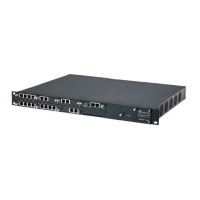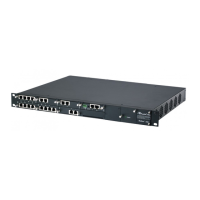User's Manual 362 Document #: LTRT-27055
Mediant 1000B Gateway & E-SBC
Parameter Description
Note: The parameter is applicable only to User-type IP Groups.
SBC PSAP Mode
sbc-psap-mode
[IPGroup_SBCPSAPMode]
Enables E9-1-1 emergency call routing in a Microsoft Skype for
Business environment.
[0] Disable (default)
[1] Enable
For more information, see E9-1-1 Support for Microsoft Skype for
Business on page 292.
Route Using Request URI
Port
use-requri-port
[IPGroup_SBCRouteUsingR
equestURIPort]
Enables the device to use the port indicated in the Request-URI of the
incoming message as the destination port when routing the message
to the IP Group. The device uses the IP address (and not port) that is
configured for the Proxy Set associated with the IP Group. The
parameter thus allows the device to route calls to the same server (IP
Group), but different port.
[0] Disable = (Default) The port configured for the associated Proxy
Set is used as the destination port.
[1] Enable = The port indicated in the Request-URI of the incoming
message is used as the destination port.
Keep Original Call-ID
sbc-keep-call-id
[IPGroup_SBCKeepOriginal
CallID]
Enables the device to use the same call identification (SIP Call-ID
header value) received in incoming messages for the call identification
in outgoing messages. The call identification value is contained in the
SIP Call-ID header.
[0] No = (Default) The device creates a new Call-ID value for the
outgoing message.
[1] Yes = The device uses the same Call-ID value received in the
incoming message for the Call-ID in the outgoing message.
Note: When the device sends an INVITE as a result of a REFER/3xx
termination, the device always creates a new Call-ID value and
ignores the parameter's settings.
Dial Plan
sbc-dial-plan-name
[IPGroup_SBCDialPlanNam
e]
Assigns a Dial Plan to the IP Group. The device searches the Dial
Plan for a dial plan rule that matches the source number and if not
found, for a rule that matches the destination number. If a matching
dial plan rule is found, the rule's tag is used in the routing and/or
manipulation processes as source and/or destination tags.
To configure Dial Plans, see Configuring Dial Plans on page 735.
Note: For IP-to-IP Routing rules that are configured for destination
based on tags (i.e., 'Destination Type' parameter configured to
Destination Tag), the parameter is applicable only to the source IP
Group and the device searches the Dial Plan for a dial plan rule that
matches the prefix of the destination number only. For more
information on routing based on destination tags, see Using Dial Plan
Tags for Routing Destinations on page 745.
Tags
tags
[IPGroup_Tags]
Assigns a Dial Plan tag that is used to determine whether the incoming
SIP dialog is sent to this IP Group. The parameter is used when IP-to-
IP Routing rules are configured for destination based on tags (i.e.,
'Destination Type' parameter configured to Destination Tag). For
more information on routing based on destination tags, see Using Dial
Plan Tags for Routing Destinations on page
745.
Call Setup Rules Set ID Assigns a Call Setup Rule Set ID to the IP Group. The device runs the
Call Setup rule immediately before the routing stage (i.e., only after the

